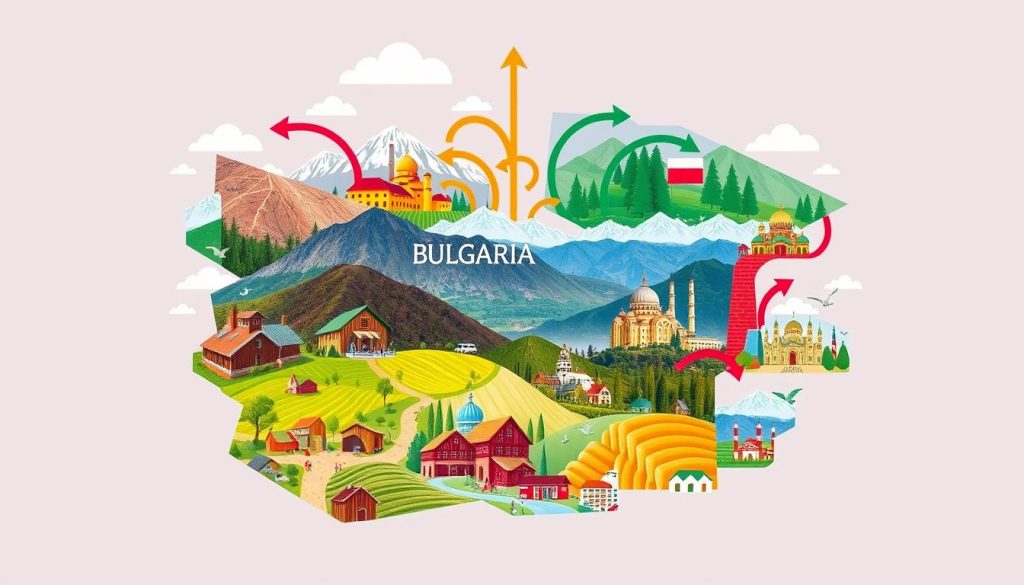In Bulgaria, Structural Business Statistics (SBS) are key to understanding business trends. They help policymakers and analysts see how businesses are doing. This information is crucial for making smart decisions about the economy.
These statistics are important for checking how well industries are doing. In 2022, Bulgaria had 394,135 active businesses, a 3.2% rise from the year before. This shows the country’s economy is growing. Also, 39,445 new businesses started, with 83.1% still going strong after a year.
SBS is more than just numbers. It tells us about the changing business scene in Bulgaria. By looking at these stats, we can help the economy grow stronger. This benefits everyone in the country.
Overview of Business Demography in Bulgaria
Business demography gives us key insights into how businesses grow and sometimes close in Bulgaria. It shows the journey of a business from starting up to possibly shutting down. This helps us understand the economic scene better.
The Life Cycle of Enterprises
In Bulgaria, businesses go through different stages. They start with setting up, then grow, become stable, and might leave the market. Knowing these stages helps us see the bigger picture of the economy.
Key Variables in Business Demography
When we look at business demography in Bulgaria, some important factors stand out. These include:
- The number of total enterprises
- Turnover of active entities
- Value added at factor cost
- Employment statistics
These variables give a complete view of the business world. They help us understand the economy better. By looking at NACE Rev. 2 data, we can see how different businesses fit into Bulgaria’s economy.
Understanding Non-Financial Enterprises
We look at non-financial enterprises using NACE BG 2008 data. This data shows how businesses are spread across different sizes. It also helps us see how much they contribute to the economy through turnover and value added. Employment figures give us a glimpse into the work environment in these sectors.
Annual Data by Size Class (NACE BG 2008)
In 2022, Bulgaria saw a 3.2% rise in active non-financial enterprises to 394,135. Most of these are micro and small businesses. This shows how important these smaller businesses are for the economy.
Turnover and Value Added at Factor Cost
Looking at turnover gives us clues about how well non-financial enterprises are doing. High turnover means strong economic activity. Value added at factor cost shows the real wealth created. By studying these, we can see how much these businesses help Bulgaria’s economy.
Employment Statistics
Employment figures tell us a lot about our labour market. They show how non-financial enterprises affect job creation. These numbers show the importance of these businesses in keeping employment and growth going.
Structural Business Statistics in Bulgaria
Structural business statistics are key to understanding Bulgaria’s economy. They give us insights into different sectors, helping us see trends and policy effects. This knowledge helps us track economic performance and make better decisions.
Significance of SBS in Economic Analysis
Structural business statistics help us dive deep into Bulgaria’s economic health. They show us important details like turnover, jobs, and business types. This detailed look helps us make smart choices and see how sectors like manufacturing and services affect the economy.
Data Coverage and Categories
Structural business statistics cover many areas important for a true picture of Bulgaria’s economy. They include data on specific activities, like:
- Turnover statistics that show how well businesses are doing financially.
- Employment statistics that tell us about jobs in different sectors.
- Demographic data that shows the variety and spread of businesses.
This wide range of data helps us track economic changes and see how policies work. Knowing these categories is crucial for understanding Bulgaria’s economic structure.
Financial Enterprises and Economic Impact
Financial enterprises are crucial for Bulgaria’s economy. They affect many sectors. We’ll look at insurance and pension funds, and the role of investment and credit institutions. Knowing these helps us understand the economy’s overall impact.
Insurance and Pension Funds Dynamics
Insurance and pension funds protect people’s and businesses’ financial futures. They manage risks and offer security against unexpected events. As the economy changes, their ability to adapt is key.
Recent trends show steady growth. Bulgaria’s GDP is expected to grow by 2.4% in the next years. This growth boosts pension funds’ credibility, protecting their contributors’ interests.
Investment and Credit Institutions’ Role
Investment and credit institutions help fund new projects. They support economic growth and encourage business growth. In the first half of 2024, employment rose by 19.6%.
This shows their positive effect on jobs. With a general government deficit of -2.6% of GDP in 2024, their financial health is vital. A good investment and credit environment leads to more innovation and economic strength.

Trends in Active Enterprises Over the Years
In recent years, Bulgaria has seen big changes in active enterprises. The way businesses register has changed a lot. This shows how the economy and new businesses are doing.
Yearly Changes in Active Enterprises
In 2022, Bulgaria saw a big jump in new businesses. There were 39,445 new ones, making up 10% of all active enterprises. This shows a strong spirit of entrepreneurship in the country.
Our studies look at these yearly changes. They show how Bulgarian businesses have grown and changed over time.
Survival Rates of Newly Established Enterprises
The survival rates of new businesses tell us a lot. In 2021, about 83.1% of them made it to the next year. This is good news for the business world.
Small to medium-sized businesses with 5 to 9 employees did especially well. This shows they are key for Bulgaria’s growth. Knowing these survival rates helps us see the challenges and chances for new businesses.
Regional Economic Performance Analysis
We look into how different regions in Bulgaria do economically. We use annual data to see their strengths and weaknesses. This helps us understand the economic differences between cities and countryside. It also shows which areas need special help to grow.
Annual Regional Data Insights
Some regions in Bulgaria do much better than others. Cities are big in making things and providing services, which is a big part of the country’s wealth. The trade sector is also strong, creating many jobs.
This sector is key for the economy. It shows how important services are to the country’s success.
Workforce Distribution Across Regions
The way people work varies a lot between cities and countryside. Cities have more jobs, especially in services and making things. But, rural areas struggle to find enough work.
This shows we need to help all areas grow equally. It’s important for everyone to have a fair chance at work.

Sectoral Performance and Contributions
In Bulgaria, we see how different sectors like manufacturing, services, and construction are key. They help create the country’s economic output. Looking at these sectors shows us their strengths and how they work together to boost the economy.
The services sector stands out for its growth and resilience. For example, business services like logistics and legal services are doing well. This is thanks to more demand and making more money. The sector’s score of 109 shows its big role in Bulgaria’s economy.
But, there are still hurdles. Foreign direct investment growth is slow, mainly in services. Also, public sector innovation is hindered by training issues and unclear goals. This analysis shows Bulgaria’s economic state and the need for support in innovation and solving sector problems.

